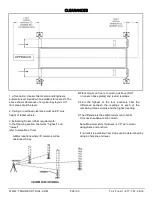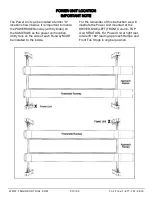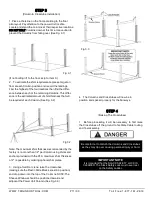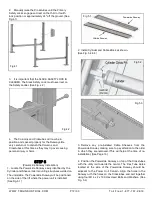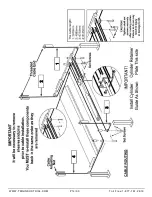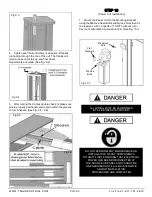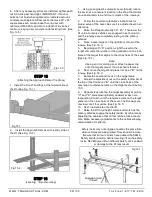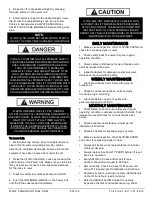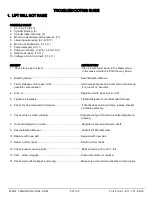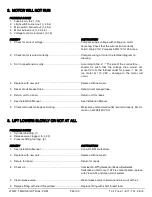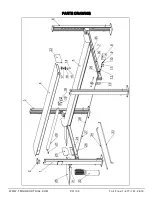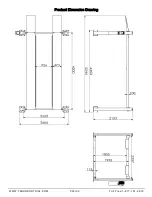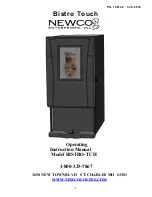
VISUALLY CONFIRM THAT ALL PRIMARY SAFETY
LOCKS ARE ENGAGED BEFORE ENTERING WORK
AREA. SUSPENSION COMPONENTS USED ON
THIS LIFT ARE INTENDED TO RAISEAND
LOWER LIFT ONLY AND ARE NOT MEANT TO BE
LOAD HOLDING DEVICES. REMAIN CLEAR OF
ELEVATED LIFT UNLESS VISUAL CONFIRMATION
IS MADE THAT ALL PRIMARY SAFETY LOCKS ARE
FULLY ENGAGED AND THE LIFT IS LOWERED ONTO
THE SAFETY LOCKS, REFER TO INSTALLATION/
OPERATION MANUAL FOR PROPER SAFETY LOCK
PROCEDURES AND/OR FURTHER INSTRUCTION.
4.
Raise the lift to the desired height by pressing
the push button on the power unit.
5.
After vehicle is raised to the desired height, lower
the lift onto the nearest Safety Lock. Do not allow
Cables to become slack. ALWAYS ENSURE ALL
SAFETY LOCKS ARE ENGAGED before entering work
area.
To Lower Lift;
1.
Before lowering vehicle, be sure all personnel are
clear of the lift and surrounding area. Pay careful
attention to overhead clearances. Ensure all tools and
equipment have been cleared from under the lift.
2.
Raise the lift off of the Safety Locks by pressing the
push button on the Power Unit. Make sure you raise the
lift by at least two inches to allow adequate clearance
for the locks to clear.
3.
Press the safety lock release handle and HOLD.
4.
Push the LOWERING HANDLE on the Power Unit
until the lift has descended completely.
DAILY MAINTENANCE
1.
Make a visual inspection of ALL MOVING PARTS and
check for excessive signs of wear.
2.
Check safety locks to ensure they are in good
operating condition.
3.
Check cables and sheaves for wear. Replace worn
parts as required the parts.
4.
Inspect adapters for damage or excessive wear.
Replace as required with the parts.
WEEKLY MAINTENANCE
1.
Lubricate all Sheave and rollers with general
purpose oil.
2.
Check all Cable connections, bolts and pins
to ensure proper mounting.
3.
Lubricate Safety Lock pivot points with
general purpose oil or WD-40.
MONTHLY MAINTENANCE
1.
Check Safety Locks to ensure they are in good
operating condition. Lubricate locking latch shafts. Push
release arm several times for oil to penetrate pivot
points.
2.
Check equalizer cable tension. Adjust per lift
installation instructions.
3.
Check all Cables for excessive signs of wear.
4.
Make a visual inspection of ALL MOVING PARTS
and check for excessive signs of wear.
•
Always call local service representative if electrical
problems develop.
•
Always replace ALL FAULTY PARTS before lift is put
back into operation.
•
Every 3 Months: Check anchor bolt torque.
Anchors should be torqued to 90 ft/lbs.
•
Semi-Annually: Check fluid level of lift power unit
and refill if required per lift installation instructions.
•
Replace all caution, warning or safety related decals
on the lift if unable to read or missing.
•
Refer to ANSI/ALI ALOIM booklet for periodic
inspection checklist and maintenance log sheet.
NOTE:
ALLOW (2) SECONDS BETWEEN MOTOR STARTS.
FAILURE TO COMPLY MAY CAUSE MOTOR BURNOUT.
IF YOU ARE NOT COMPLETELY FAMILIAR WITH
AUTOMOTIVE LIFT MAINTENANCE PROCEDURES;
STOP AND CONTACT THE MANUFACTURER FOR
INSTRUCTIONS. TO AVOID PERSONAL INJURY,
PERMIT ONLYQUALIFIED PERSONNEL TO PERFORM
MAINTENANCE ON THIS EQUIPMENT.
WHEN LOWERING THE LIFT PAY CAREFUL
ATTENTION THAT ALL PERSONNEL AND OBJECTS
ARE KEPT CLEAR. ALWAYS KEEP A VISUAL LINE OF
SIGHT ON THE LIFT AT ALL TIMES. ALWAYS
MAKE SURE THAT ALL LOCKS ARE DISENGAGED.
IF ONE OF THE LOCKS INADVERTENTLY LOCKS
UPON DESCENT THE VEHICLE MAY DISMOUNT
CAUSING PERSONAL INJURY ORDEATH.
WWW.TMGINDUSTRIAL.COM
P23/33
Toll Free:1-877-761-2819

